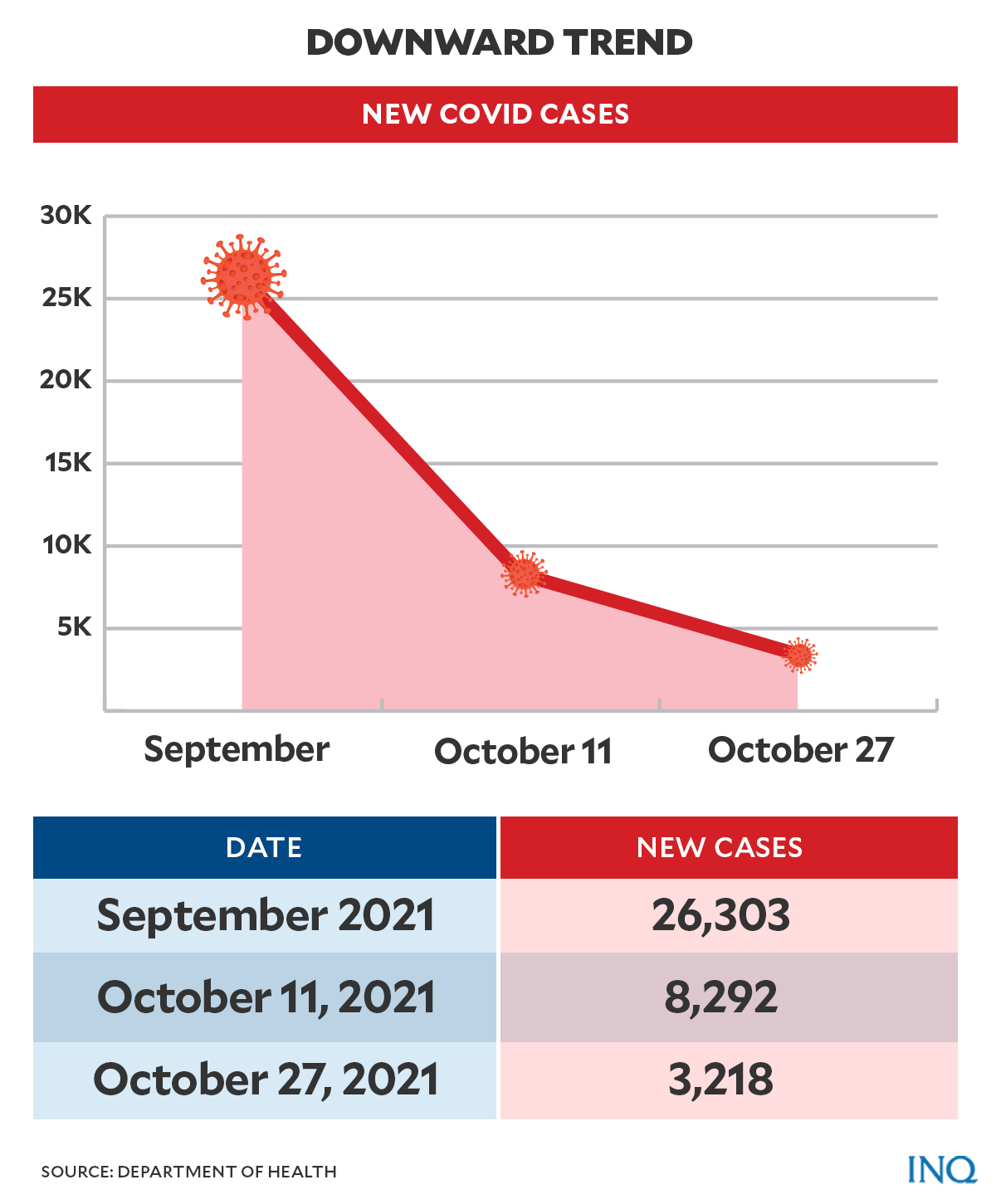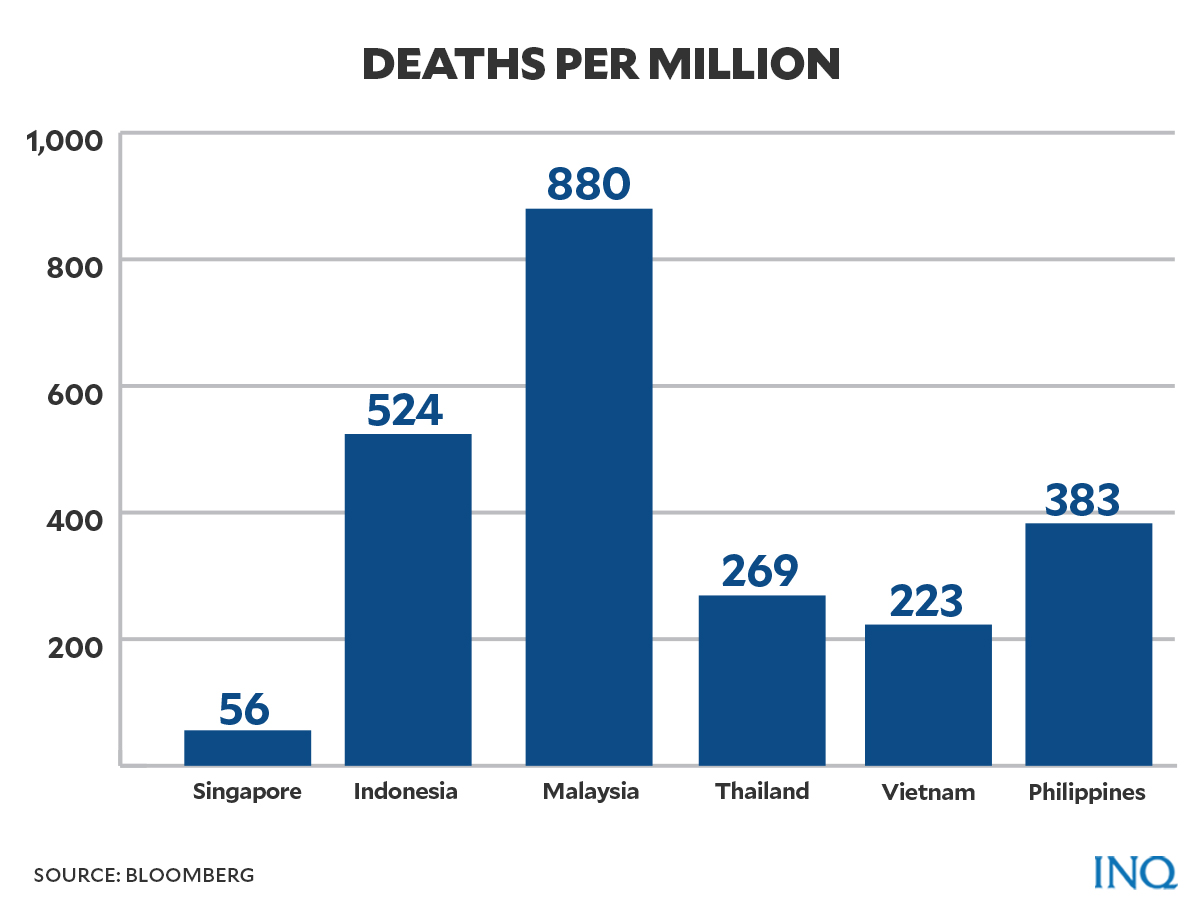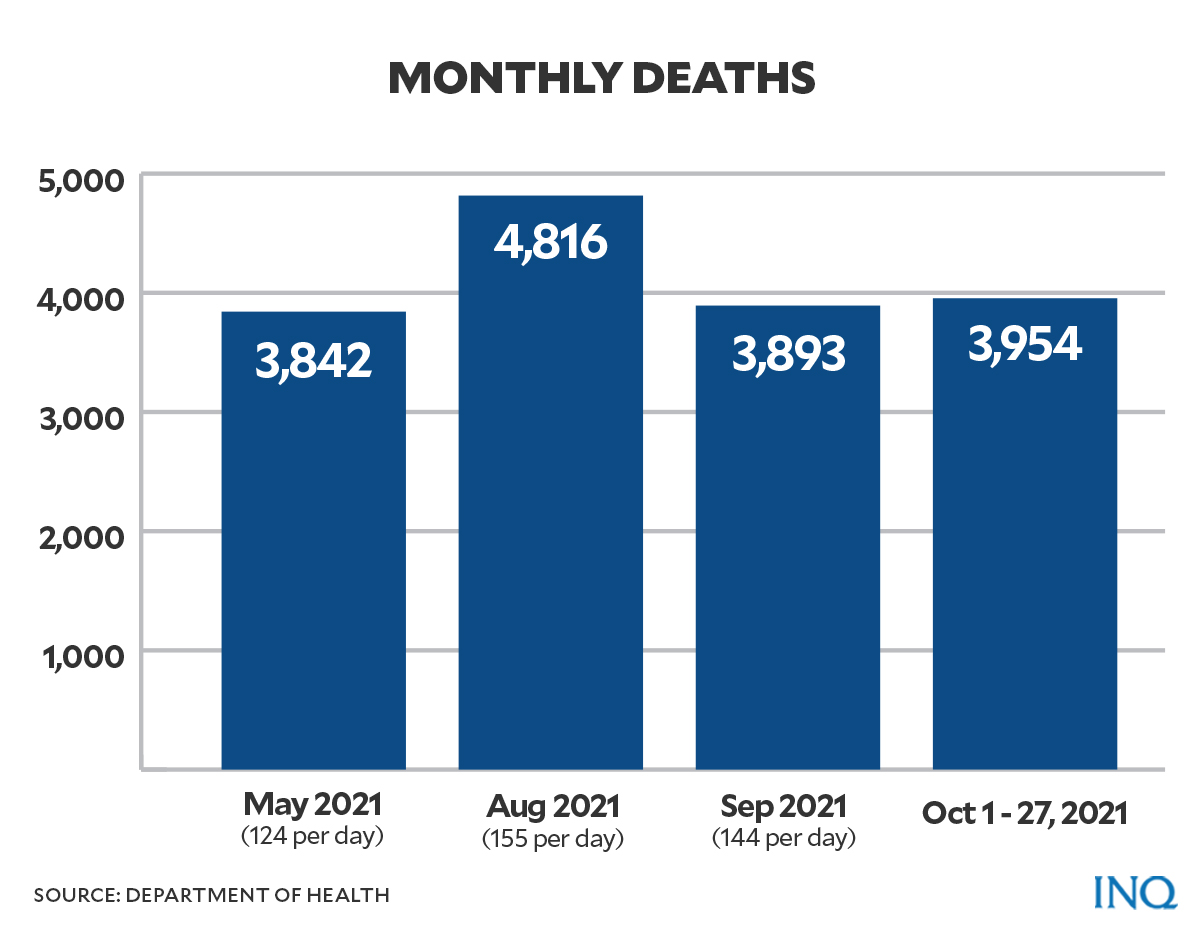No victory declaration yet as COVID cases fall in PH

FILE PHOTO: People wear face mask and face shields to help curb the spread of COVID-19 as they walk along the streets in Quezon city, Philippines on Wednesday, Aug. 19, 2020. Philippine President Rodrigo Duterte has decided to ease a mild coronavirus lockdown in the capital and four outlying provinces to further reopen the country’s battered economy despite having the most reported infections in Southeast Asia. (AP Photo/Aaron Favila)
MANILA, Philippines—The number of daily coronavirus infections in the Philippines has been dropping dramatically over the past few weeks. While this could be good news, should it be taken as a sign of victory in the war on COVID-19?
In this report, we tried to look beyond the number of new COVID-19 cases to see whether the country is already winning its fight against the disease, which still has no known cure.
Declining COVID-19 cases
When the number of reported daily infections peaked last September, reaching an all-time high of 26,303—paired with then-increasing cases of the highly transmissible Delta variant—the Department of Health (DOH) had projected that the cases would peak again in October.
READ: PH records highest COVID-19 case count at 26,303 — DOH
But last Oct. 11, the number of new cases dropped to 8,292. The figures have been going down since then.
On Oct. 27, the health department logged 3,218 new infections, the lowest since May 23, when the country recorded 3,083 new cases.
Article continues after this advertisement
Graphic by Ed Lustan
The number of active COVID-19 cases has also been dropping this month.
Article continues after this advertisementIn September, the number of active cases was between 130,000 to over 180,000. But since Oct. 10 the active cases started to go down to 90,927.
On Oct. 28, the number of active cases further dipped to only 49,835, the lowest since mid-July.
The daily positivity rate—or the percentage of all COVID-19 tests performed that are actually positive—also decreased from 21.3 percent on Oct. 1, 22.1 percent on Oct. 2 and 7.6 percent on Oct. 27.
According to OCTA Research fellow Guido David, the seven-day average of new cases in the entire country from Oct. 20 to 26 likewise decreased to 4,848.
“The last time cases were this low was March 12 to 18,” David said in a Twitter post.
“Based on the current trends, cases could decrease to less than 2k by end of [November],” he added.
OCTA Research also saw a drop in the country’s COVID-19 reproduction number to 0.52. According to President Rodrigo Duterte, this was below the 1.00 deemed ideal by the World Health Organization (WHO).
READ: ‘We thank God,’ Duterte says, noting drop in COVID-19 reproduction number
Last week, David projected that the number of new COVID infections would decrease to the pre-Delta variant surge level by the end of October.
“Based on current trends, the country is tracking at less than 5k new cases (7-day average) by end of October with less than 1k in the NCR. This means we expect numbers to return to pre-Delta surge level by end of October,” said David.
READ: OCTA: PH’s COVID-19 cases may decrease to pre-Delta surge level by end-October
The decreasing number of COVID-19 cases has eased the Philippines to low-risk status as of Oct. 25, according to DOH.
READ: Philippines now classified as low risk for COVID-19
Bottom of resilience ranking
But despite the downtrend in daily infections, the Philippines has yet again landed on the bottom of the list of Bloomberg’s COVID Resilience Ranking report.
For the second consecutive month, the Philippines ranked last among 53 countries in the report with a score of 40.5—slightly higher than 40.2 in September.
READ: PH still at bottom of COVID-19 economic resilience ranking
Despite decreasing COVID-19 cases, the Philippines lagged behind its neighbor Southeast Asian countries due to its slow vaccine progress.
According to the Bloomberg report, the Philippines fared among “the worst on vaccine coverage” with only 26 percent of its population vaccinated.
In comparison, here are the number of people covered by vaccines in Asean countries on the list:

Graphic by Ed Lustan
- Singapore (Ranked 39) – 87.8 percent
- Indonesia (Ranked 48) – 34.2 percent
- Malaysia (Ranked 50) – 75.6 percent
- Thailand (Ranked 51) – 50.6 percent
- Vietnam (Ranked 52) – 37.8 percent
- Philippines (Ranked 53) – 26 percent
According to the group Bantay Bakuna, as of Oct. 23, the country has 94,678,340 total doses of the COVID-19 vaccine. The group said these doses could vaccinate at least 42.9 percent of the country’s total population, or about 47.3 million individuals.
If the seven-day average of 478,368 doses administered each day would remain consistent, the group said it would take seven months to achieve the government’s target of vaccinating 70 percent or 77 million people.
READ: PH injection rates fail to catch up with vaccine supply
Amid slow progress, the government will soon begin its nationwide rollout of COVID vaccination for minors aged 12 to 17 years old.
Vaccine czar Carlito Galvez, a former armed forces chief of staff, said the National Vaccination Operations Center had told him the vaccination of minors could start as early as Nov. 3.
READ: Vaccination of minors 12-17 yrs old starts Nov. 3, says Galvez
Earlier this week, Health Secretary Francisco Duque III also approved the recommendation by the Health Technology Assessment Council (HTAC) to give booster shots and additional doses for priority groups.
When Bloomberg released its report in September, Malacañang blamed the issue on vaccine shortage, which was also true in other Southeast Asian countries, according to presidential spokesperson Harry Roque.
“We are not surprised that the Philippines, together with other Southeast Asian countries such as Indonesia, Thailand, Malaysia, and Vietnam are at the bottom of the list, while countries which topped the list are developed countries such as Ireland, Spain, Netherlands, Finland and Denmark,” Roque had said in a statement.
“Vaccines are key towards defeating COVID -19,” he said.
“Unfortunately, as President Rodrigo Roa Duterte articulated in the United Nations, ‘rich countries hoard life-saving vaccines, while poor nations wait for trickles.’” Roque said.
“The Philippines is a classic case in point, where inoculation is highly dependent on the availability and stability of vaccine supplies,” he added.
READ: The cost of delayed vaccination
COVID deaths
Although the Philippines had a lower number of deaths per one million people compared to Malaysia and Indonesia, David said the country’s high number of COVID fatalities remains “concerning.”
According to the Bloomberg report, deaths per million in Southeast Asian countries are:

Graphic by Ed Lustan
- Singapore (Ranked 39) – 56 deaths per 1 million
- Indonesia (Ranked 48) – 524 deaths per 1 million
- Malaysia (Ranked 50) – 880 deaths per 1 million
- Thailand (Ranked 51) – 269 deaths per 1 million
- Vietnam (Ranked 52) – 223 deaths per 1 million
- Philippines (Ranked 53) – 383 deaths per 1 million
In August, the country had its highest COVID death toll since the pandemic started last year with 4,816 total deaths or at least 155 deaths per day.
It surpassed the previous record of 4,060 deaths in April.
In September, 3,893 people died of COVID, or an average of 144 per day. This made September the third deadliest month after surpassing the record in May with 3,842 recorded deaths or at least 124 deaths per day.
READ: August worst month for COVID-19 deaths – DOH

Graphic by Ed Lustan
However, data from Oct. 1 to Oct. 27 showed that there are now a total of 3,954 deaths—which were already higher than the total fatalities recorded in September.
‘Don’t be complacent’
Although the Philippines is seeing a decline in the number of new COVID cases this month, the government has been reminding the public to not be complacent as the pandemic was far from over.
“Although the number of new COVID-19 cases reported in recent days has been declining, we should not be complacent,” the DOH reminded in its latest bulletin.
“Instead, let us continue to adhere to minimum public health standards and get vaccinated immediately,” it added.
However, in the past two weekends, many people failed to heed the DOH advisory and one case of that was driven by the government itself—overcrowding on Manila Bay’s controversial dolomite beach.
Over the weekend, reports said authorities have recorded over 4,000 individuals on portion of Manila Bay that had been covered with crushed dolomite rocks.
This was despite MMDA chair Benhur Abalos’ advice for people against overcrowding on the dolomite beach as it could lead to a superspreader, or a major source of infection, event.
Malacañang on Monday (Oct. 25) warned the public against overcrowding and law enforcers against negligence in the wake of people packing the dolomite beach.
“We are calling on the public to remember that we are still under a pandemic, even if our daily cases have started decreasing, COVID-19 is still present so we should not be complacent,” Roque said.
“We are also calling on the police in Manila, we need to enforce proper social distancing because the dolomite beach is for the enjoyment of everyone but we do not want it to be a source of a superspreader event,” he added.
READ: Potential ‘superspreader’: Palace warns vs complacency amid Manila dolomite beach frenzy
On Wednesday (Oct. 27) Environment Undersecretary Benny Antiporda urged people who recently visited the dolomite beach to go on self-quarantine.
“Just to keep them safe also, we would like to request that they take [pre]caution,” Antiporda said.
“They should go on self-quarantine, for now, to make sure that they did not contract any disease last Sunday,” he added.
TSB
For more news about the novel coronavirus click here.
What you need to know about Coronavirus.
For more information on COVID-19, call the DOH Hotline: (02) 86517800 local 1149/1150.
The Inquirer Foundation supports our healthcare frontliners and is still accepting cash donations to be deposited at Banco de Oro (BDO) current account #007960018860 or donate through PayMaya using this link.